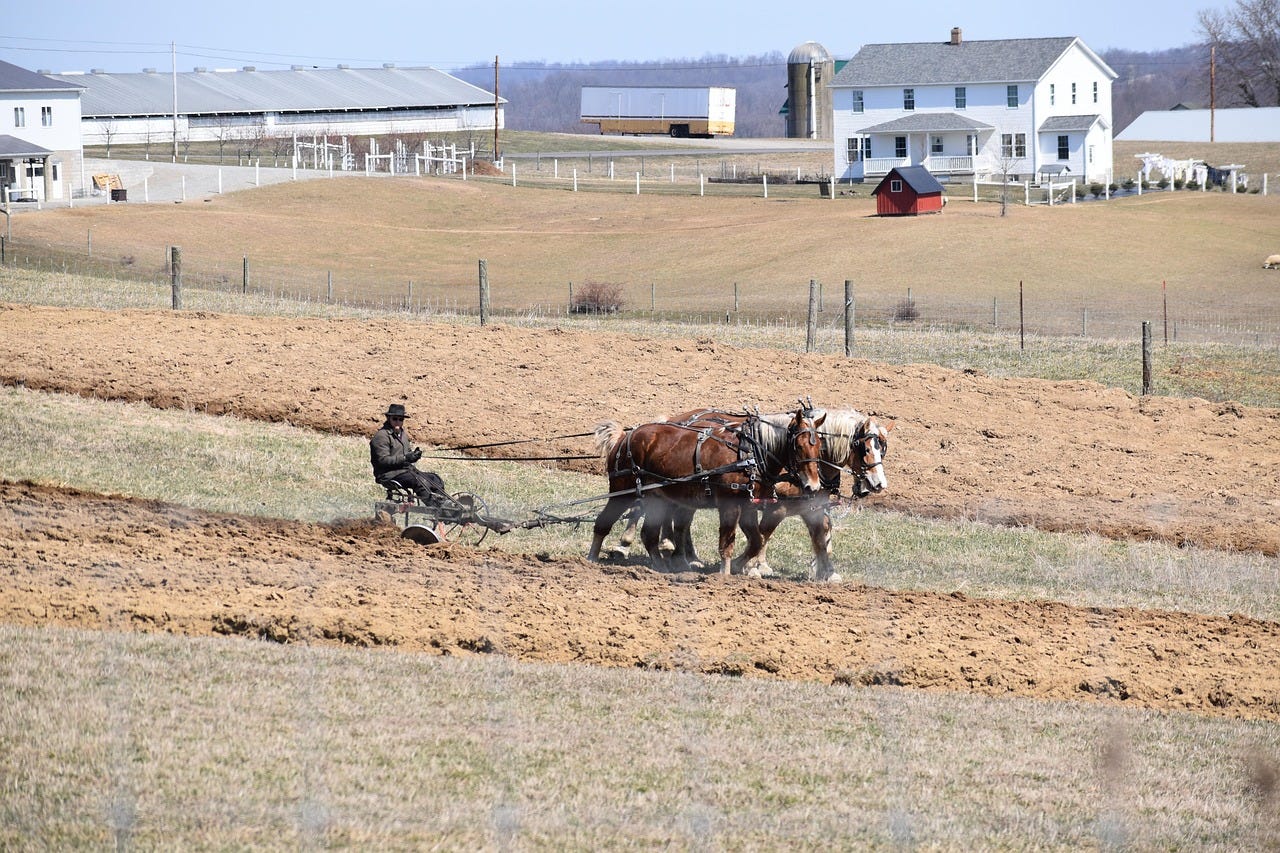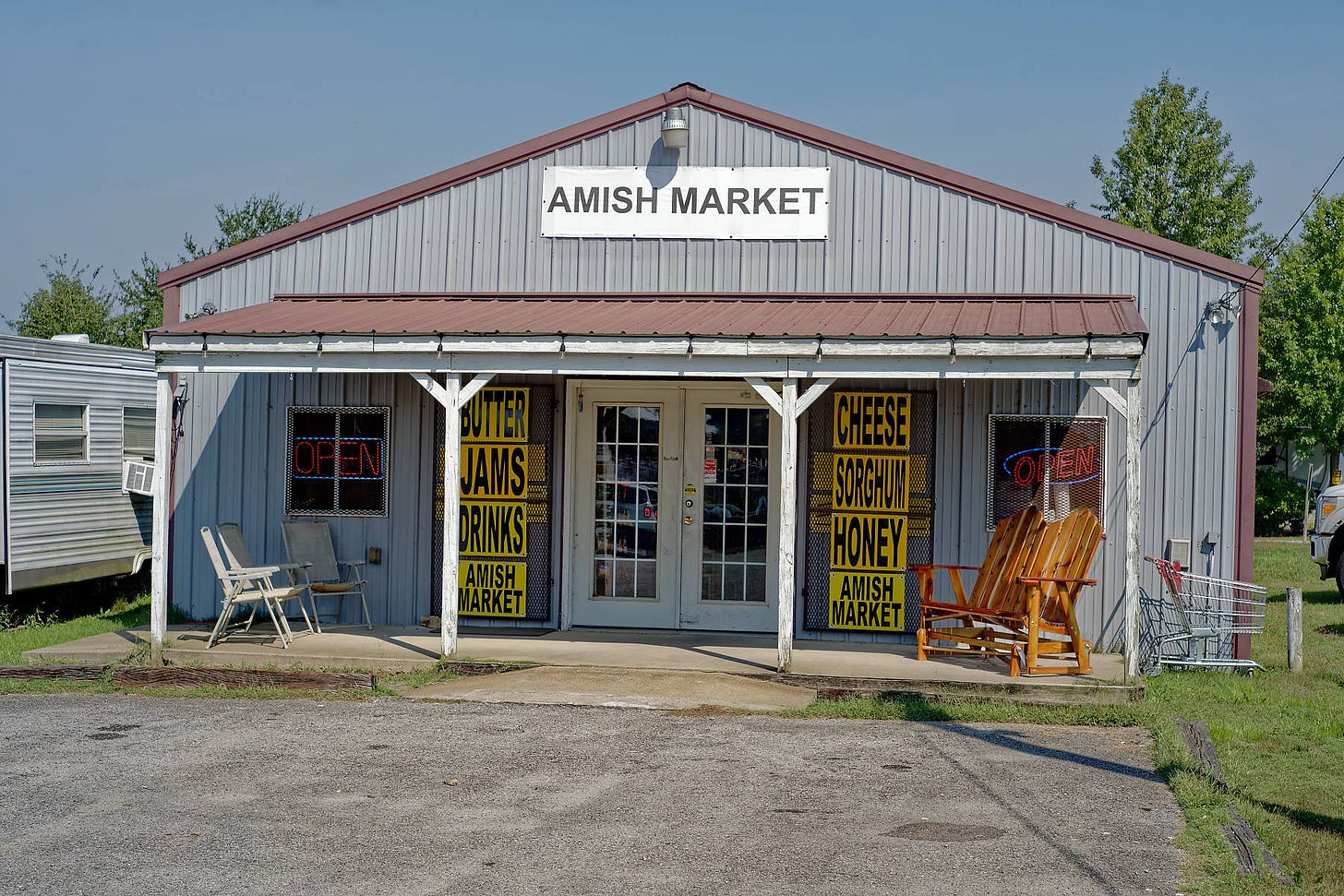In this second edition of my look at inspirations for ‘Big Team Farms, ’ I wanted to dive into a particularly enigmatic group of people – the Amish.
The Amish have captured our collective imagination in a way few groups in contemporary America have. Their steadfast commitment to an agrarian way of life, free of the demands of modern life, draws our interest. They have been particularly successful at maintaining thriving rural communities in a period where such livelihoods are becoming more difficult to sustain. To understand why this is, an exploration of the interaction between Amish culture and economics is in order.
Cultural preconditions
The Amish are a highly values-driven people. All aspects of their society are organized by the rules of the Ordnung, translated as order. The Ordnung is an oral tradition that prescribes both ethics and practice. These directives differ by group, with some being more conservative and communal, while others have adopted more permissive customs. Some are engaged in missionary practices, and others allow for more technology in their communities. Overall, though, the twin goals of the Ordnung are to keep the community unified and to ensure a strong commitment to the virtues of discipline, obedience, humility, patience, plainness, and truthfulness (Kraybill, 2013). Amish lifeways flow from these principles.
The economies of the Amish are molded by these virtues. Commitment to frugality means the Amish have a propensity to prefer more conservative savings vehicles, like real estate. Instead of accumulating assets to spend on consumer goods or college, purchases that would violate mores around humility and worldliness, they accumulate cash and direct it towards purchasing farmland or starting small businesses. The ethics engendered by the Ordnung manifests itself in specific economic preferences, which result, over the long term, in the accumulation of farmland and a focus on agriculture as a core industry. In search of farmland, Amish communities are spreading across the country, with new settlements being established in their historic range of Pennsylvania, Indiana, and Ohio, as well as emerging in new states like New Mexico, Colorado, and Wyoming (Myers, 2024).

This process is supported by historical circumstances. Before emigrating to the United States, many Amish communities in Europe coalesced around the Rhine River in modern-day Germany. At the time, land markets in continental Europe were inaccessible to the peasantry, with leasing and crop share arrangements being the main way poor farmers eked out a living (Kraybill, 2013). Unfortunately for the nascent Anabaptists, this led to their community being fractured and ever moving, making it difficult to establish deep roots with their brethren and weakened the moral disposition of the denomination. When they migrated to North America, Amish leaders heavily promoted the establishment of communities that owned the land they farmed, cementing a generational disposition towards land ownership and agricultural lifestyles above all.
Finally, a key priority within the culture is against ‘worldliness’ and ensuring Amish individuals live close to and socialize with one another to maintain the community's moral center. The isolation of rural areas and the independence one can achieve farming solidifies the Amish commitment to farming. This ideological and historic veneration, coupled with the economic alignment farming has with Amish morality, has led the Amish to shape their lifestyles around the land (Grabbe, 2017).
The evolution of Amish farm enterprises
Historically, the Amish farmed quite similarly to the English (the term the Amish use for Americans). They both used the muscle of horse and man, passed seed down through the generations, and fertilized with manure instead of ammonia. As the mechanization of agriculture took place in the late 1800s to early 1900s, however, the methods of farming changed drastically between the two. The Amish maintained the old ways, while the English slowly adopted a decidedly industrial form of agriculture. Markets adjusted to this new reality, favoring farmers who could grow crops at scale. This proved an existential threat to the Amish, who found it difficult to compete. This is epitomized by Christner Yoder, an Amish farmer in eastern Iowa who advises his children, “Don't raise anything that can be combined . . . You can't compete with a combine” (Love, 2012).

In light of a changing world, the Amish are anything but static. They are constantly adapting to changing conditions to preserve their lifestyles. One example includes shifting technological tolerances. The Amish are not categorically against technology, but instead, they take an incredibly cautious approach to integrating new innovations into their homes and businesses. Scholar Donald Kraybill describes their approach as “move slow, be careful.” This extends to the farm, where occasional modifications to new technologies can be made to improve competitiveness while minimizing the impact on community cohesion. This includes Amish dairy farmers adopting automatic milkers. Other times, marketing strategies are what change. Many Amish dairy farmers switched from selling drinking grade milk to selling cheese grade milk, since the cooling requirements for the latter are less stringent, with technologies that were easier for the community to stomach (Cross, 2014).
The pursuit of new markets epitomizes the Amish response to agricultural transition. This includes establishing greenhouses to grow ornamentals and retail garden plants. Pet rearing and the raising of game animals for hunting ranches are other cottage industries that have been successful in certain communities (Kraybill, 2013).
This search for new industries is a strategic one that plays on their unique characteristics. Their large families provide abundant labor that can be channeled towards certain enterprises. This allows the Amish to be particularly competitive in growing produce, a sector where much labor is still done by human hands. Organic farming, which involves less modern technology, is another area where the Amish excel since the disparity between their capabilities and those of the English is lower (Kraybill, 2013).
Unique opportunities can be found in marketing as well, especially among value-added goods. The Amish have built up a lot of cultural cache among the general public as a wholesome people who produce quality, handmade products. This effectively amounts to a brand, one that is considered highly desirable among consumers. This has allowed the Amish to be quite successful selling baked goods, deli products, health foods, jams, and candies marketed at farmers' markets, local retail outlets, and occasionally wholesale (Kraybill, 2013). Additionally, these products fit well within a broader “catalog” of Amish-made goods, including furniture, cabinets, and quilts. There's a certain synergy between these categories that makes the Amish brand a one-stop shop for countryside goods.

Synthesis
Looking at the Amish approach to farming enterprises, it seems that they are masters at combining ideological dedication with practical adaptation. They have a vision for the lives they wish to lead, understand the values that underlie that vision, and forge a path to maintaining their society into the modern day. Despite the restrictions’s religion places on their activities, they have been able to identify strengths that differentiate them and their products in the marketplace. By playing to these strengths and evolving on their terms, they have successfully built agrarian businesses that support a lively and growing community in an era where vibrant rural livelihoods are hard to come by.
Another pillar of their success has been a blending of communal support and entrepreneurship. They operate mortgage funds to support new families in purchasing land, mutual aid systems to maintain social welfare, and labor sharing schemes to drive development, all towards their common enrichment. Set within this environment, however, is a thriving network of small businesses and cottage industries operated independently by individuals and families. This balance between individual work ethic along with a sense of duty to one’s neighbors has been a driving force in Amish economic life.
All in all, values-driven diligence, thrift, and rural idealism have, over time, led to the intensive development of enterprises that serve Amish lifestyles and communities. While this model would be difficult to replicate intentionally, playing to strengths, pursuing value-added and specialty enterprises, and a focus on principled rural living are key lessons when studying the Amish model. While an Anabaptist faith is not required to establish collaborative agricultural enterprises, a clear commitment to an agrarian lifestyle and orientation of one’s economic life around that goal seems to be a big part of the reason for the success of the Amish model.
What I’m Reading, Watching, and Listening to
30 minutes with a stranger: A visual story recounting 1,500 conversations between strangers and how talking with those we don’t know makes us feel.
Governance Lessons From the Constitutional Convention: A deep dive into the logistics of the writing of our constitution.
Rural Life, Marginal Life, Good Life: A meditation on life at the edges.




